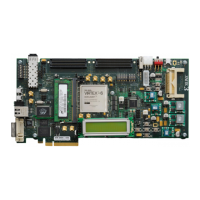Virtex-6 FPGA GTX Transceivers User Guide www.xilinx.com 181
UG366 (v2.5) January 17, 2011
TX Out-of-Band Signaling
The GTX transceiver supports beaconing as described in the PHY Interface for the PCI
Express (PIPE) Specification. The format of the beacon sequence is controlled by the FPGA
logic.
Ports and Attributes
Table 3-34 defines the TX OOB ports.
Table 3-35 defines the TX OOB attributes.
The GTX transceiver supports four signaling modes: three for SATA/SAS operations and
one for PCI Express operations. The use of these mechanisms is mutually exclusive.
Table 3-34: TX OOB Ports
Port Direction Clock Domain Description
COMFINISH Out TXUSRCLK2 This output indicates completion of transmission of the last
SAS or SATA TXCOM sequence.
TXCOMINIT In TXUSRCLK2 This input initiates the transmission of the TXCOMINIT
sequence.
TXCOMSAS In TXUSRCLK2 This input initiates the transmission of the TXCOMSAS
sequence.
TXCOMWAKE In TXUSRCLK2 This input initiates the transmission of the TXCOMWAKE
sequence.
TXELECIDLE In TXUSRCLK2 When in the PCIe P2 power state, this signal controls
whether an electrical idle or a beacon indication is driven
onto the TX pair. When in SATA mode, keep TXELECIDLE
High for generating SATA/SAS OOB COM signaling.
TXPOWERDOWN[1:0] In TXUSRCLK2 This input powers down the TX lanes. It is primarily used for
PCIe designs. Use TXPOWERDOWN = 00 for operating
SATA OOB signaling.
Table 3-35: TX OOB Attributes
Attribute Type Description
COM_BURST_VAL 4-bit Binary This attribute determines the number of bursts in a COM
sequence.
TXPLL_SATA 2-bit Binary Reserved. Use only recommended values from the
Virtex-6 FPGA GTX Transceiver Wizard.

